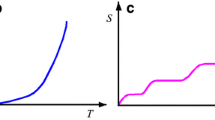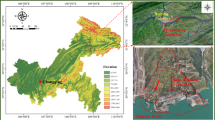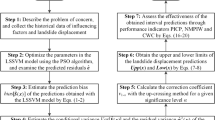Abstract
The accuracy of landslide displacement prediction can effectively prevent casualties and economic losses. To achieve accurate prediction of the Majiagou landslide displacement in the Three Gorges Reservoir (TGR), China, a hybrid machine learning prediction model considering the deformation hysteresis effect is proposed. The real-time deep displacement measurements were captured by using in-place inclinometers with Fiber Bragg grating (FBG) sensors. The time series method was adopted to divide the total displacement into a trend term and periodic term. Trend displacement was determined by the geological condition and predicted by the fitting method. Periodic displacement was controlled by external factors such as rainfall and fluctuation of reservoir water level. Before making the prediction, the grey correlation analysis was adopted to confirm that the fluctuation of the reservoir water level was the main influence factor. In view of the deficiency that current prediction methods could not quantitatively determine the lag time of landslide deformation and thus select the influencing factors empirically, the dynamic analysis of the correlation between periodic influence factors and periodic displacement was carried out in this paper, and the deformation lag time was identified to be 18 days by using set pair analysis (SPA) method. Finally, the optimal influence factors were selected and the prediction model of Majiagou landslide based on support vector machine optimized by particle swarm optimization (SPA-PSO-SVM) was established. Results showed that the root mean square error (RMSE) and the mean absolute percentage error (MAPE) of the proposed SPA-PSO-SVM prediction model are 0.28 and 12.8, respectively. Compared with the PSO-SVM model, the prediction accuracy of the proposed model had been improved significantly. The reliability and effectiveness of the SPA-PSO-SVM prediction model is verified and it has apparent advantages while predicting landslide displacement with deformation hysteresis effect involved.














Similar content being viewed by others
References
Akbarimehr M, Motagh M, Haghshenas-Haghighi M (2013) Slope stability assessment of the Sarcheshmeh landslide, Northeast Iran, investigated using InSAR and GPS observations. Remote Sens 5(8):3681–3700
Baldi P, Cenni N, Fabris M, Zanutta A (2008) Kinematics of a landslide derived from archival photogrammetry and GPS data. Geomorphology 102(3-4):435–444
Bernardie S, Desramaut N, Malet JP, Gourlay M, Grandjean G (2015) Prediction of changes in landslide rates induced by rainfall. Landslides 12(3):481–494
Bui DT, Tuan TA, Hoang ND, Thanh NQ, Nguyen DB, Van Liem N, Pradhan B (2017) Spatial prediction of rainfall-induced landslides for the Lao Cai area (Vietnam) using a hybrid intelligent approach of least squares support vector machines inference model and artificial bee colony optimization. Landslides 14(2):447–458
Carlà T, Intrieri E, Di Traglia F, Nolesini T, Gigli G, Casagli N (2017) Guidelines on the use of inverse velocity method as a tool for setting alarm thresholds and forecasting landslides and structure collapses. Landslides 14(2):517–534
Chang CC, Lin CJ (2011) LIBSVM: a library for support vector machines. ACM Trans Intell Syst Technol 2(3):27
Chawla A, Chawla S, Pasupuleti S, Rao ACS, Sarkar K, Dwivedi R (2018) Landslide susceptibility mapping in Darjeeling Himalayas, India. Adv Civ Eng 2018:6416492
Corinna C, Vapnik V (1995) Support-vector networks. Mach Learn 20(3):273–297
Corominas J, Moya J, Lloret A, Gili JA, Angeli MG, Pasuto A, Silvano S (2000) Measurement of landslide displacements using a wire extensometer. Eng Geol 55(3):149–166
Deng J (1988) Grey forecasting and decision making. Huazhong University of Science and Technology Press, Wuhan, pp 86–128
Deng DM, Liang Y, Wang LQ, Wang CS, Sun ZH, Wang C, Dong MM (2017) Displacement prediction method based on ensemble empirical mode decomposition and support vector machine regression—a case of landslides in Three Gorges Reservoir area. Rock Soil Mech 12(38):1001–1009
Du J, Yin K, Lacasse S (2013) Displacement prediction in colluvial landslides, three Gorges reservoir, China. Landslides 10(2):203–218
Farzan A, Mashohor S, Ramli AR, Mahmud R (2015) Boosting diagnosis accuracy of Alzheimer's disease using high dimensional recognition of longitudinal brain atrophy patterns. Behav Brain Res 290:124–130
Han HM, Zhang L, Shi B, Wei GQ (2019) Prediction of deep displacement of Majiagou landslide based on optical fiber monitoring and PSO-SVM model. J Eng Geol 27(4):853–861. https://doi.org/10.13544/j.cnki.jeg.2018-257 (in chinese)
Hu XL, Tan FL, Tang HM, Zhang GC, Su AJ, Xu C, Zhang YM, Xiong CR (2017) In-situ monitoring platform and preliminary analysis of monitoring data of Majiagou landslide with stabilizing piles. Eng Geol 228:323–336. https://doi.org/10.1016/j.enggeo.2017.09.001
Huang CL, Dun JF (2008) A distributed PSO–SVM hybrid system with feature selection and parameter optimization. Appl Soft Comput 8(4):1381–1391
Huang F, Huang J, Jiang S, Zhou C (2017) Landslide displacement prediction based on multivariate chaotic model and extreme learning machine. Eng Geol 218:173–186
Jiao YY, Zhang HQ, Tang HM, Zhang XL, Adoko AC, Tian HN (2014) Simulating the process of reservoir-impoundment-induced landslide using the extended DDA method. Eng Geol 182:37–48
Lepore C, Kamal SA, Shanahan P, Bras RL (2012) Rainfall-induced landslide susceptibility zonation of Puerto Rico. Environ Earth Sci 66(6):1667–1681
Li XZ, Xu Q (2003) Models and Criteria of Landslide Prediction. J Catastrophol 18(4):71–78 (in Chinese)
Lian C, Zeng Z, Yao W, Tang H (2014) Ensemble of extreme learning machine for landslide displacement prediction based on time series analysis. Neural Comput & Applic 24(1):99–107
Liu X, Tang HM, Liu Y (2009) Landslide deformation dynamic modeling research based on set pair analysis. Rock Soil Mech 30(8):166–173 (in chinese)
Ma JW, Tang HM, Liu X, Hu X, Sun M, Song Y (2017) Establishment of a deformation forecasting model for a step-like landslide based on decision tree C5. 0 and two-step cluster algorithms: a case study in the Three Gorges Reservoir area, China. Landslides 14(3):1275–1281
Miao F, Wu Y, Xie Y, Li Y (2018) Prediction of landslide displacement with step-like behavior based on multialgorithm optimization and a support vector regression model. Landslides 15(3):475–488
Paronuzzi P, Rigo E, Bolla A (2013) Influence of filling–drawdown cycles of the Vajont reservoir on Mt. Toc slope stability. Geomorphology 191:75–93
Parsopoulos KE, Vrahatis MN (2002) Recent approaches to global optimization problems through particle swarm optimization. Nat Comput 1(2-3):235–306
Poli R, Kennedy J, Blackwell T (2007) Particle swarm optimization. Swarm Intell 1(1):33–57
Qin S, Jiao JJ, Wang SJ (2001) The predictable time scale of landslides. B Eng Geol Environ 59(4):307–312
Ren F, Wu X, Zhang K, Niu R (2015) Application of wavelet analysis and a particle swarm-optimized support vector machine to predict the displacement of the Shuping landslide in the Three Gorges, China. Environ Earth Sci 73(8):4791–4804
Shihabudheen KV, Pillai GN, Peethambaran B (2017) Prediction of landslide displacement with controlling factors using extreme learning adaptive neuro-fuzzy inference system (ELANFIS). Appl Soft Comput 61:892–904
Stark TD, Choi H (2008) Slope inclinometers for landslides. Landslides 5(3):339–350
Sun YJ, Zhang D, Shi B, Tong HJ, Wei GQ, Wang X (2014) Distributed acquisition, characterization and process analysis of multi-field information in slopes. Eng Geol 182:49–62. https://doi.org/10.1016/j.enggeo.2014.08.025
Tang MG, Xu Q, Yang H, Li SL, Iqbal Javed FXL, Huang XB, Cheng WM (2019) Activity law and hydraulics mechanism of landslides with different sliding surface and permeability in the Three Gorges Reservoir Area, China. Eng Geol 260:105212
Vallet A, Charlier JB, Fabbri O, Bertrand C, Carry N, Mudry J (2016) Functioning and precipitation-displacement modelling of rainfall-induced deep-seated landslides subject to creep deformation. Landslides 13(4):653–670
Vapnik VN (2000) The nature of statistical learning theory. Statistics for Engineering and Information Science. Springer, New York
Wang F, Li T (2009) Landslide disaster mitigation in Three Gorges reservoir, China. Mt Res Dev 30:184–185
Wang FW, Zhang YM, Huo ZT, Matsumoto T, Huang BL (2004a) The July 14, 2003 Qianjiangping landslide, three gorges reservoir, China. Landslides 1(2):157–162
Wang Y, Yin K, An G (2004b) Grey correlation analysis of landslide sensitive factor. Rock Soil Mech 01:91–93
Wang Y, Jing H, Yu L, Su H, Luo N (2017) Set pair analysis for risk assessment of water inrush in karst tunnels. B Eng Geol Environ 76(3):1199–1207
Wolter A, Stead D, Clague JJ (2014) A morphologic characterisation of the 1963 Vajont Slide, Italy, using long-range terrestrial photogrammetry. Geomorphology 206:147–164
Wu X, Shen S, Niu R (2016) Landslide susceptibility prediction using GIS and PSO-SVM. Geomatics Inf Sci Wuhan Univ
Xu S, Niu R (2018) Displacement prediction of Baijiabao landslide based on empirical mode decomposition and long short-term memory neural network in Three Gorges area, China. Comput Geosci 111:87–96
Zhang YM, Hu XL, Tannant DD, Zhang G, Tan FL (2018a) Field monitoring and deformation characteristics of a landslide with piles in the Three Gorges Reservoir area. Landslides 15(3):581–592. https://doi.org/10.1007/s10346-018-0945-9
Zhang CC, Zhu HH, Liu S, Shi B, Zhang D (2018b) A kinematic method for calculating shear displacements of landslides using distributed fiber optic strain measurements. Eng Geol 234:83–96
Zhang W, Xiao R, Shi B, Zhu HH, Sun Y (2019) Forecasting slope deformation field using correlated grey model updated with time correction factor and background value optimization. Eng Geol 260:105215
Zhao KQ (1989) Theory and analysis of set pair e a new concept and system analysis method. In: Conference Thesis of System Theory and Regional Planning, pp 87–91
Zhou C, Yin K, Cao Y, Ahmed B (2016) Application of time series analysis and PSO–SVM model in predicting the Bazimen landslide in the Three Gorges Reservoir, China. Eng Geol 204:108–120
Acknowledgments
The authors gratefully acknowledge the financial support provided by the State Key Program of National Natural Science Foundation of China (Grant No. 41427801) and the National Key R & D Program of China (Grant No. 2018YFC1505104). Special thanks are given to B. P. Naveen of Amity University Haryana for making corrections to this paper in English. The authors also thank the efforts of the technicians from Suzhou NanZee Sensing Technology Co., Ltd. and other participants in this research work.
Author information
Authors and Affiliations
Corresponding authors
Electronic supplementary material
ESM 1
Correlation between the water level fluctuation velocity (+ is on the rise and – is falling), water level and displacement velocity measured in inclinometers B8 (DOCX 5363 kb)
Rights and permissions
About this article
Cite this article
Zhang, L., Shi, B., Zhu, H. et al. PSO-SVM-based deep displacement prediction of Majiagou landslide considering the deformation hysteresis effect. Landslides 18, 179–193 (2021). https://doi.org/10.1007/s10346-020-01426-2
Received:
Accepted:
Published:
Issue Date:
DOI: https://doi.org/10.1007/s10346-020-01426-2




